San Diego County was “free” of the giant Southern Section and on its own, twenty-eight schools strong.
The formation of the local CIF section pleased administrators and assorted education honchos who wielded the sharp end of the stick.
Coaches and most fans were ambivalent.
The great competition against Northern schools and the building excitement of playoffs at foreign sites against largely unknown opponents was gone, replaced by two divisions and two weeks of watered-down postseason play.
Champion of 28 schools was not like champion of more than 300.
3 STAY PUT
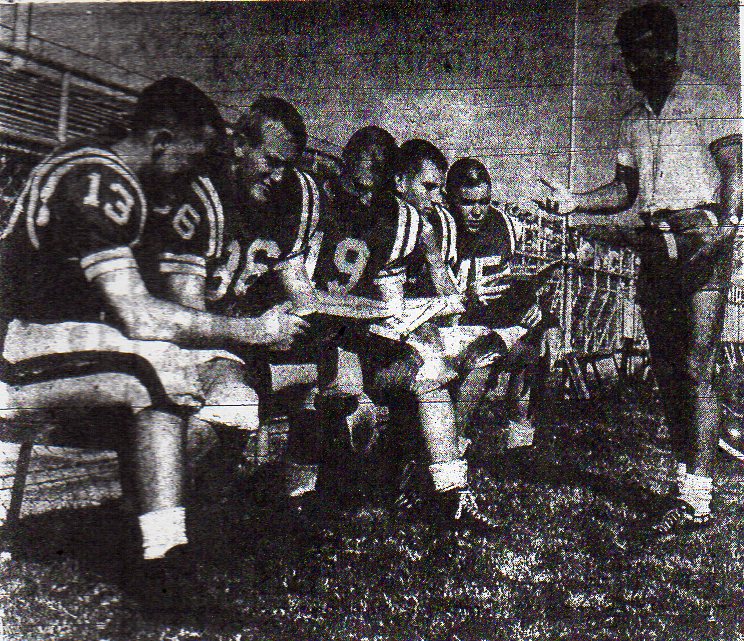
Three County affiliates did not join the new section. Mountain Empire and Rancho del Campo remained in the Southern Section and usually played more easily accessed Imperial Valley squads.
Fallbrook, 0-8 in 1957 and 0-9 in ’58 as a member of the Avocado League, was not considered strong enough to compete against schools from the North County circuit.
The Warriors had joined the DeAnza League in Riverside County in 1959 and stayed there through this football season. Their opponents were schools such as Hemet, Perris, San Jacinto, and Beaumont.
The alignment agreed with coach Al Waibel’s club, which was 3-1 in the league and 6-3 overall.
Fallbrook dropped a 32-0 decision to San Pedro Mary Star of the Sea in the first round of the Southern Section small schools playoffs.
Football at Julian still was seven years away, making 27 the actual count of football-playing schools in the San Diego Section.
San Diego fans were happy, as long as their teams were winning.
That meant that virtually every week was a celebration at Escondido High, where coach Bob (Chick) Embrey built a small school power into a major force in the new order.
The game of the year matched San Diego, at 6-2 the Eastern League champion and, by reputation, the favorite, against the 7-1-1 Cougars in the AA semifinal.
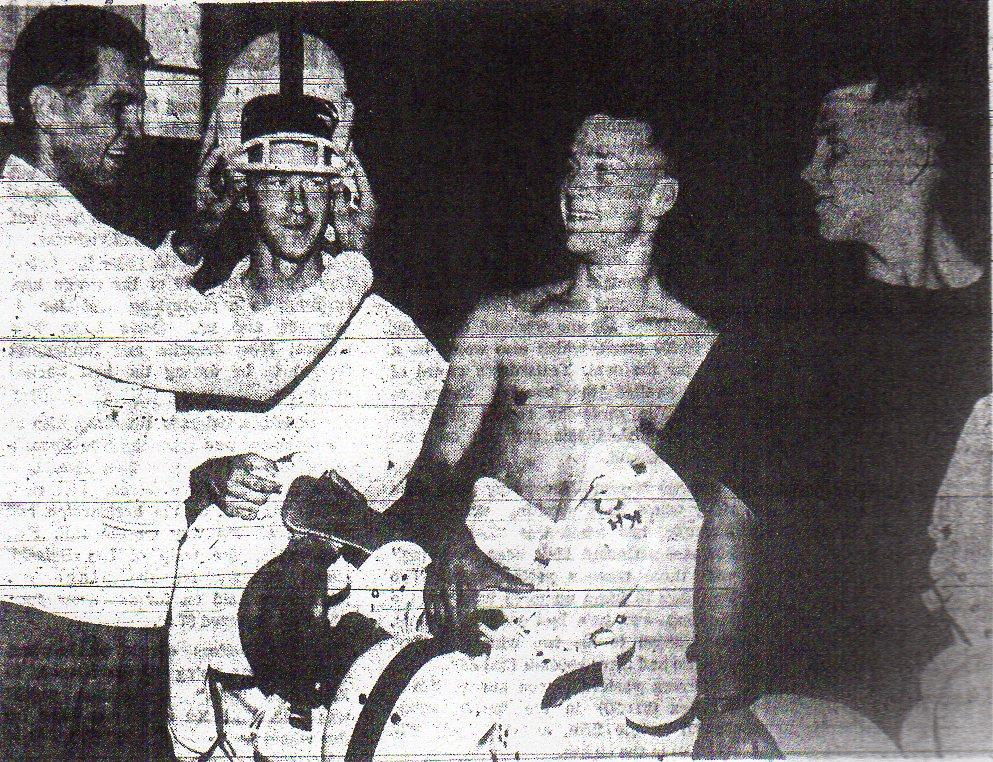
MAESTRO, MUSIC!
Escondido fired a shot across the Cavers’ bow before the kickoff.
The North County school’s pep band struck up “The March of the Olympians,” which was written for the 1960 Summer Olympics in Rome, as the Cougars marched onto the field from the South end of Balboa Stadium, helmets tucked under their arms against their sides.
They could have been matadors entering the ring.
The novel approach clearly one-upped the Cavemen, who for years cowed visiting teams with their traditional entrance down the steps from the top of Balboa Stadium’s North end zone.
COUGARS IN CONTROL
Escondido’s 19-13 victory was not as close as the final score. The Cougars outgained San Diego, 293-246, and led, 19-7, in the third quarter.
“We could have scored more, don’t you think?” enthused the jubilant Embrey.
Embrey could not have been blamed for gloating, although that was not his intention. He was Escondido’s star player in 1944, when the Cavers beat the Cougars, 20-0, in a Southern Section playoff.
Quarterback Doug Bennett completed 6 of 9 passes for 161 yards against San Diego and, as further evidence of a changing of the guard, had the fastest man on the field.
Wingback Dave Blunt was on the receiving end of a 66-yard pass play which gave the Cougars a two- touchdown lead.
Blunt also became the first San Diego Section sprint champion the following spring, running :09.7 in the 100-yard dash and 21 seconds in the 220.
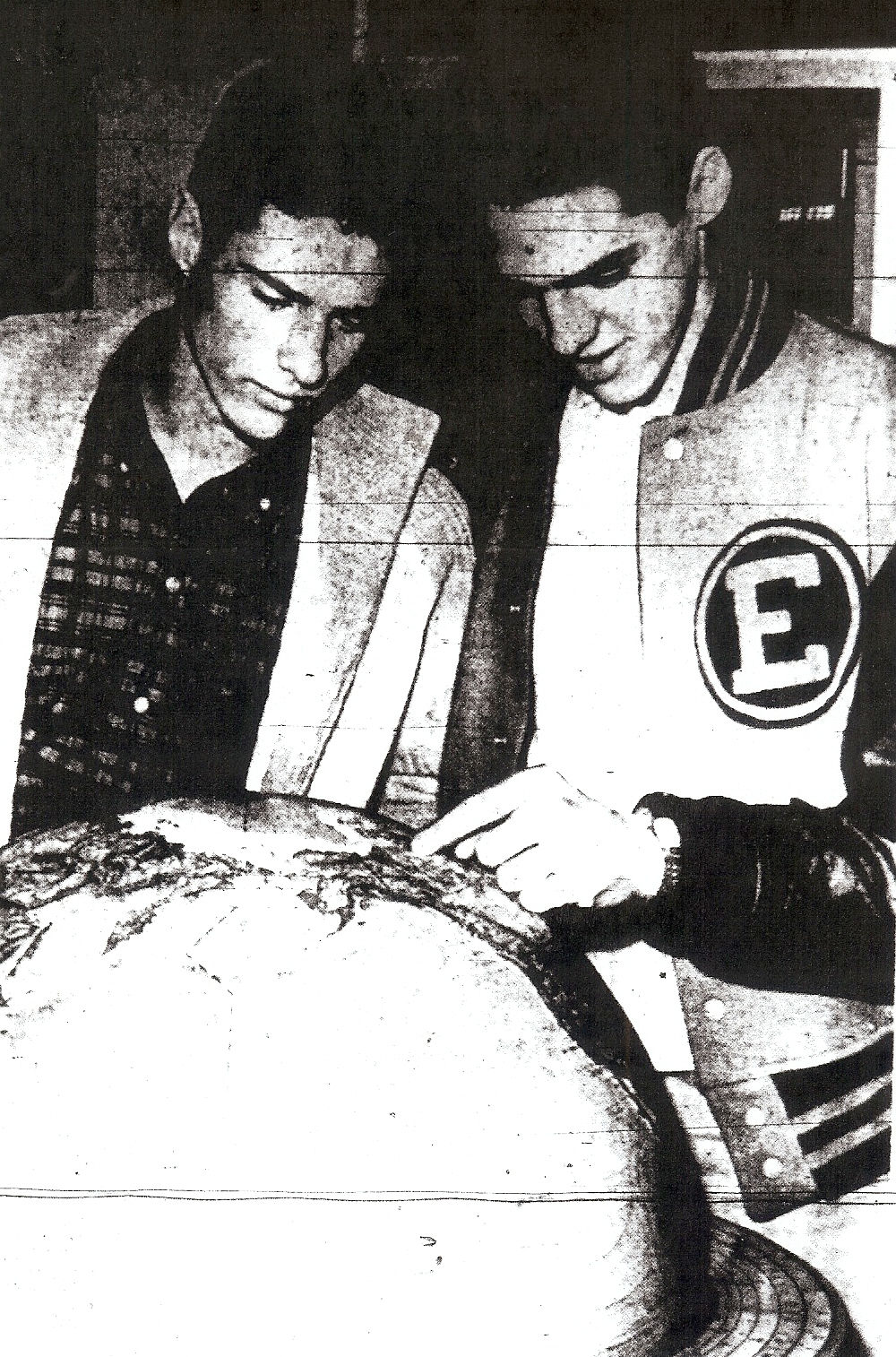
POINTERS WIN TIE
Point Loma tied Helix, 6-6, in the other semifinal and advanced because of their 13-8 advantage in first downs.
Mount Miguel, winner of five in a row since it had gone to a power ground game, in coach Harry Johnston’s words, defeated La Jolla, 7-6, and Vista beat University, 32-20, to reach the Class A, small-schools championship.
The championship games went to form.
Escondido defeated Point Loma, 20-13, before an estimated overflow crowd of 9,000 at the Cougars’ field.
Doug Bennett passed 42 yards to Dave Blunt and 4 yards to Pete Schouten and Blunt returned an intercepted pass 40 yards to give the Cougars three touchdowns and a 20-6 lead.
WHO’S A BULLY?
No one, but that was what several residents of Spring Valley thought I was calling Mount Miguel after the Matadors defeated Vista, 40-13, for the Class A title.
In my game story I made a comparison of the good big man always defeating the good little man. And I wrote, using a very trite and poor play on words, “Mount Miguel’s Matadors, a big, bullish Metropolitan League entry, overpowered Vista, a small tough Avocado Leaguer….”
I received telephone calls and letters from outraged Mount Miguel followers, saying I had called their team a bunch of bullies and most suggesting I should not show my face in Spring Valley, where the school was located.
Looking back, what was Mount Miguel doing in the small schools bracket?
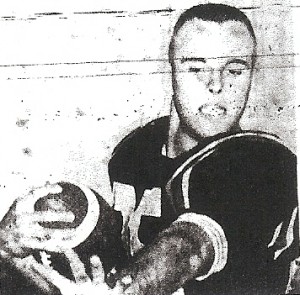
With more than 2,500 students, Mount Miguel was the largest school in the County. Vista had an enrollment of about 950.
Mount Miguel and La Jolla were the two at-large teams invited to the small school playoffs after finishing second in their large school leagues and with the best second-place records.
“They were just too big and too strong,” said Vista coach Pat Mongoven. “Maybe they’ll do something next year about those pairings.”
MATADORS’ 1-2 PUNCH
“Torge and Freeman, then comes the screamin’!” That was how Tribune writer Roger Conlee described the Mount Miguel attack.
Russ Torge gained 146 yards in 11 carries and scored two touchdowns, including one from 71 yards.
Duane Freeman had 74 yards in 14 carries, scored once, and blocked a punt which Matador John Rea returned 19 yards for a touchdown.
DOUG VS. EZELL
Doug Bennett, who played behind Steve Thurlow at Escondido in 1959, completed 98 of 155 passing attempts for 1,577 yards and 17 touchdowns in 11 games.
San Diego’s Ezell Singleton had a sizeable advantage with 28 touchdown passes in 1958, but wasn’t that far ahead with 111 completions in 179 attempts for 1,711 yards.
Bennett averaged 10.2 yards per passing attempt and Singleton 9.6. Singleton averaged 15.4 yards per completion and Bennett 16.1.
HONORS
Bennett made the all-Southern California first team. End Doug Agatep of Escondido and Helix lineman Dennis Michalenko were on the second team and Crawford running back Jim (Corky) McCorquodale was on the third team.
There were no San Diego Section players on any of the three, all-Southern Caliifornia lower division teams.
EXPANDING
The alignment would be for only one season, but the 10-team Metropolitan League was halved into Northern and Southern Divisions, geography be damned.
El Cajon, El Capitan, Escondido, Granite Hills and Hilltop formed the Northern Division. A Southern Division embraced Helix, Grossmont, Chula Vista, Mount Miguel, and Sweetwater.
The distance between division rivals Escondido and Hilltop was 36 miles. The distance between Hilltop and city neighbor and non-division opponent Chula Vista was 3 miles.
The six schools in the Grossmont League would have their own circuit in 1961, plus the new Monte Vista High in Spring Valley.
PERSISTENCE PAYS
St. Augustine’s defense braced and stopped Point Loma on the Saints’ 19, 22, 37, 24, and one-yard lines, but the Pointers finally put the 12-6 game away with a touchdown by Curtis Mosley that ended a five-play, 27-yard drive with 1:36 remaining.
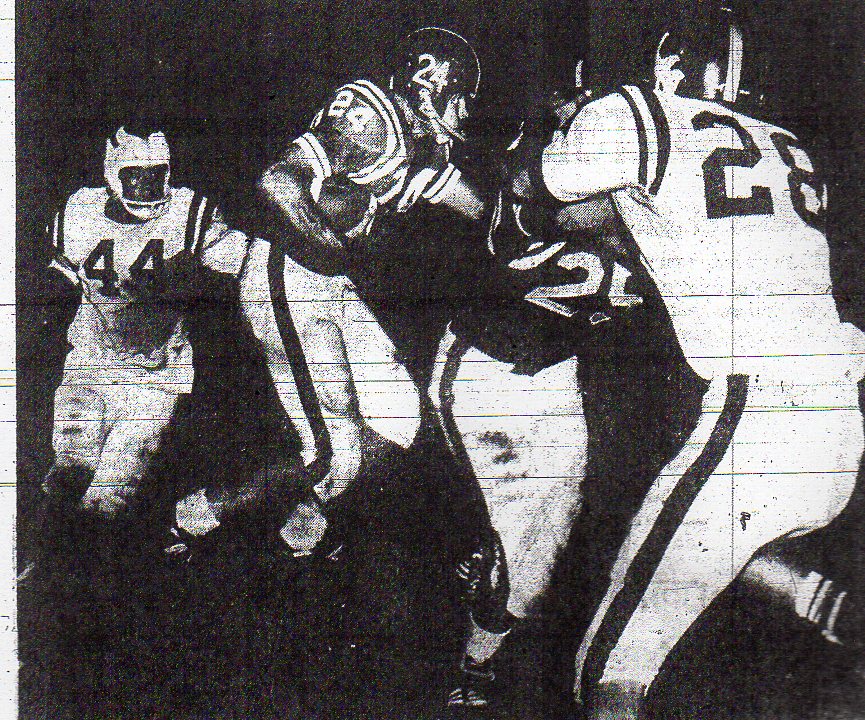
It was St. Augustine’s first loss in 14 games.
ALL-STAR GAMES AND CARNIVALS
They were abundant and they were popular.
San Diego scored its first victory in five tries over the Los Angeles City aggregation in the 12th annual Breitbard College Prep All-Star game.
The 27-12 victory, fueled by the performance of Escondido’s Steve Thurlow and San Diego High’s Richard (Prime) McClendon, came before an Aztec Bowl record turnout of 13,700.
- Thurlow faked to McClendon (20) and scored against L.A. All-Stars in 27-12 San Diego victory.
Thurlow passed for two touchdowns and ran for another. McClendon rushed for 151 yards and ran 66 yards for a score. The local squad trailed 12-0 at halftime but wore down the Los Angeles stars with a rushing attack that netted 333 yards.
The San Diego-L.A. format replaced the Southern California-L.A. game in 1956. The series started in 1949.
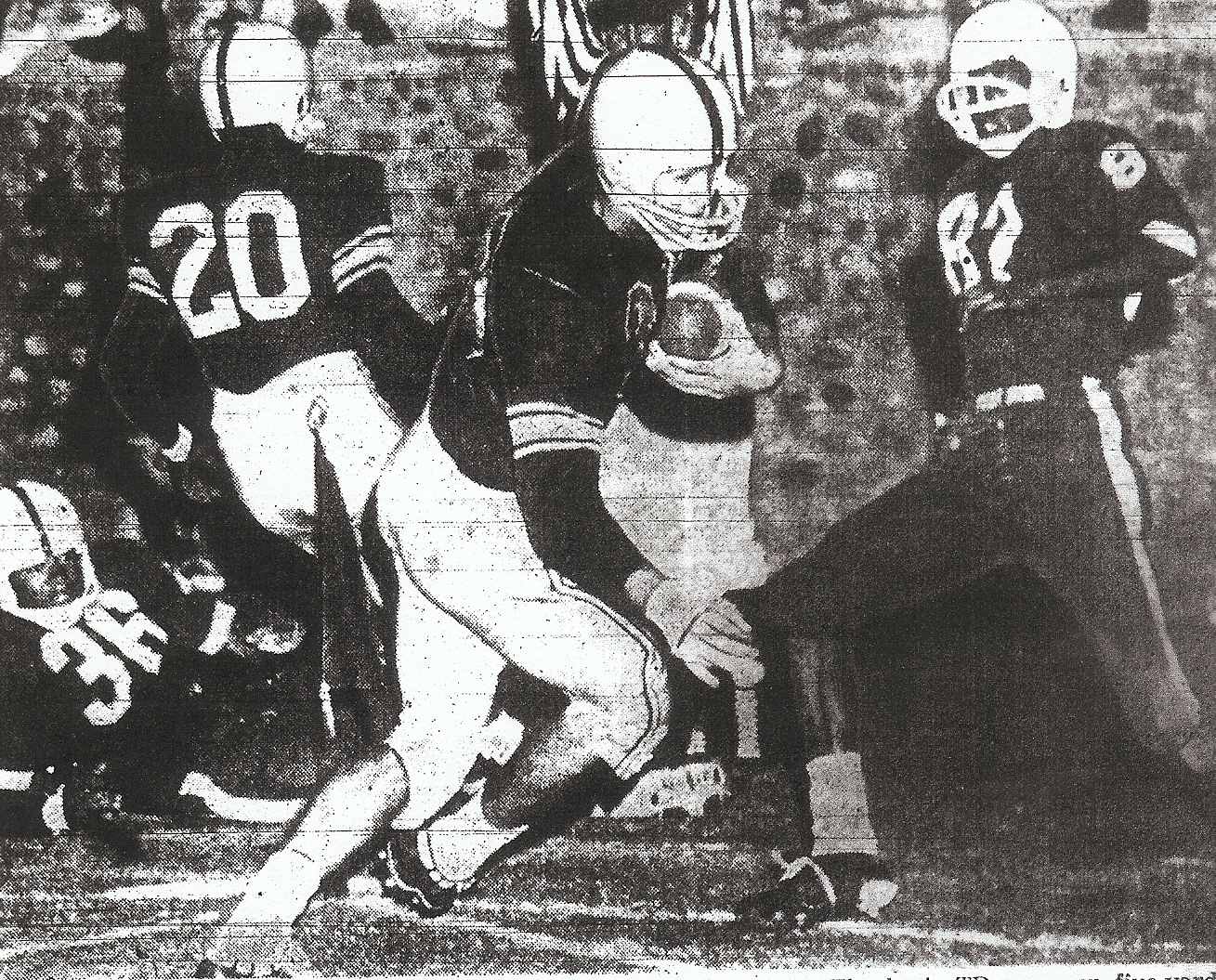
CAVERS TAKE TO AIR
Passes by the Cavers’ Lou White resulted in carnival scoring plays of 88 yards to Thomas Phillips, 22 yards to David Ortman, and 68 yards to Eddie Frost.
The Metropolitan League carnival featured only Grossmont District squads and drew a capacity crowd of 12,000 to Aztec Bowl.
Six teams played three, 20-minute quarters.
Mount Miguel, Granite Hills, and Helix of the West won, 25-6.
Mount Miguel beat El Cajon Valley, 19-0, in the second quarter after Granite Hills, teeing up for the first time, battled to a 6-6 standoff with El Capitan. Helix and Grossmont played to a scoreless deadlock in the final quarter.
START-UP INCONVENIENCES
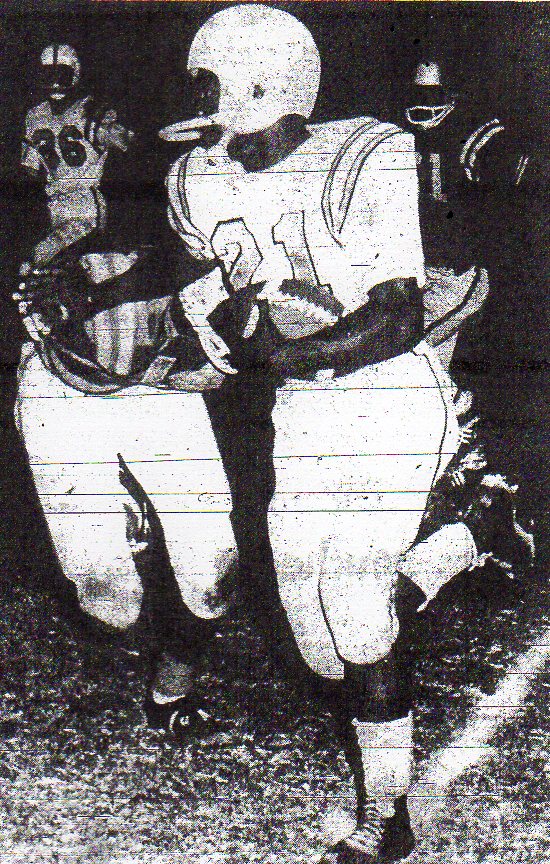
Granite Hills opened its doors for the first time, minus some of the usual necessities.
The Eagles’ one “luxury” was cold showers, but was an improvement over the initial conditions.
Coach Glenn Otterson’s team originally was forced to use hoses to wash off practice sweat and dirt. The players then had to take their uniforms home for a more complete cleaning and bring their own towels to school.
Lockers became available midway into the season. Until then, the Eagles’ used a “dressing room.” As Roger Conlee wrote in the Evening Tribune, the players piled their clothes in a bare, four-walled enclosure that was locked during practice.
“SHOWERS,” CON’T.
Four seconds remained at Mount Miguel, where Granite Hills and Sweetwater were completing a nonleague game which Sweetwater won, 20-6.
As Granite Hills quarterback Tom Roth was about the accept the snap from center, Roth and his teammates heard a hissing noise behind them.
Sprinklers went on all over the field. Scrambling officials were unable to find the automatic timing device which controlled the system, so the teams went ahead with the last play in a shower.
“Both benches (then) emptied fast,” said Otterson. “They scattered like it was a fire drill.”
UNIVERSITY OF…PENALTIES?
Coach Robert (Bull) Trometter’s University of San Diego High Dons dropped a 30-6 decision to Fallbrook.
Nothing out of the ordinary about the score but the Dons had five touchdowns erased by penalties, including 4 in the game’s first six minutes.
Uni, playing a full varsity schedule for the first time, was eager to please Trometter, the highly successful former Marine Corps Recruit Depot mentor.
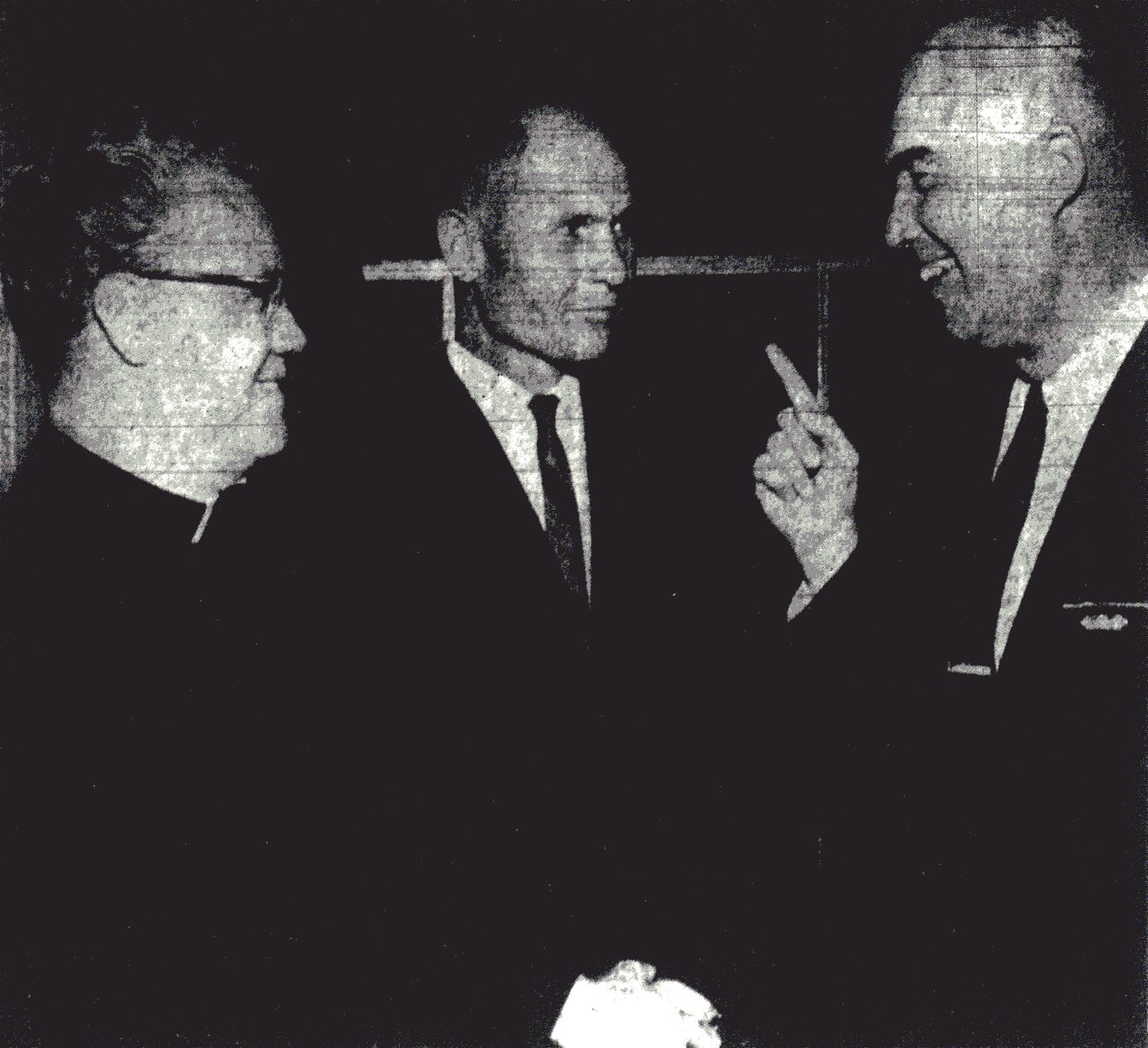
“I wouldn’t say it was the officials’ fault,” tactfully noted Trometter, a decorated, retired Marine Corps officer. The coach said his players essentially were “over-eager and inexperienced,” leading to a flood of off-sides, holding, and other violations.
The Dons dropped their first three games, won their final three and earned a first-round Class A playoff berth.
NIGHT AND DAY
Rowdism, which provoked a move of the city football carnival from evening to afternoon in 1959, was a continuing problem.
Police Chief Elmer Jansen addressed several concerns for his department, including staffing and expense, and suggested switching games to daylight.
Very Rev. John Aherne, principal at St. Augustine, was spokesman for the pro-night-games group and said crowds would be down at day games and that there was no guarantee that rowdyism would not continue.
Night games continued in the city during the playoffs after much rhetoric.
PLAY IT AGAIN, SAM
An Oceanside-Carlsbad school district trustee suggested that Oceanside and Carlsbad replay their 0-0 tie.
John Prenzel proposed an investigation to determine if such a game “would be in accord with California Interscholastic Federation rulings.”
Prenzel thought a rematch under auspices of the Oceanside Lions Club could be played on Thanksgiving Day, with proceeds going to the rival schools’ student body funds.
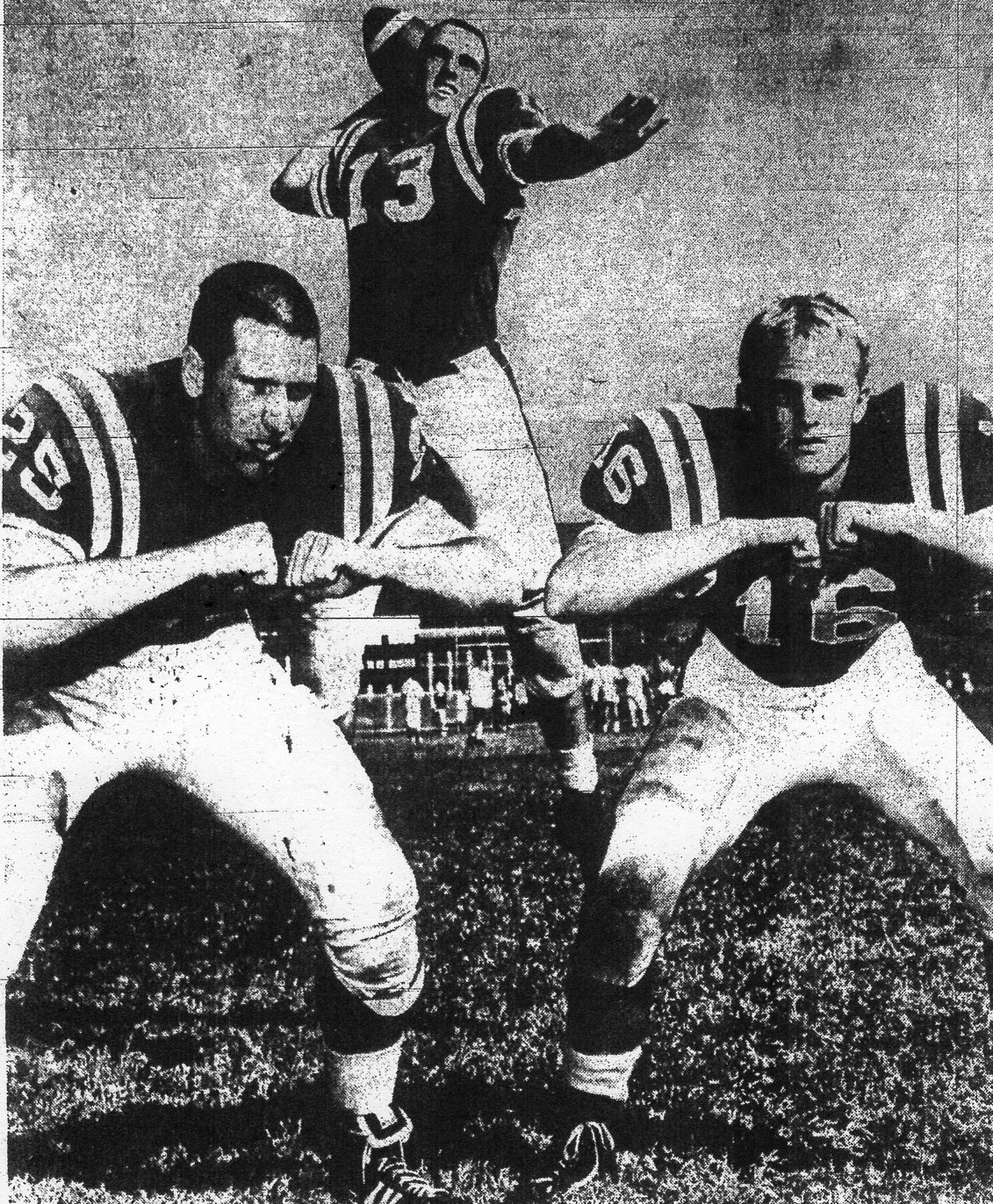
The game wouldn’t affect league standings, said Prenzel.
It was an idea whose time had not come. No action and no game took place.
PLACEMENTS POPULAR
Field goals were making a comeback, or rather they were being discovered.
After years in which no placements were made or attempted, at least four attempts were successful this year. Soccer-style kicking still was a few years away.
Coronado lost to La Jolla, 21-10, but the Islanders’ Bob West kicked a 21-yard field goal. San Dieguito’s Randy Simpson made a 34-yard placement in a 3-0 victory over El Centro Central.
Not to be outdone, Helix’ Bill Burnett was good from 25 yards in a 36-0 win over Grossmont and Fallbrook’s Jim Martin converted from 22 yards in a 24-14 win over Elsinore Military Academy.
SCHOLASTIC STUMBLES
City schools quarterly grades during the season meant academic casualties.
Clairemont, the consensus preseason favorite, would not win a league game and lost fullback Ron Power, one of the area’s better offensive players, to grade deficiencies.
Mission Bay was down to 24 players after first teamers Jeff Moran, Martin Brown, and Gene Scales were beaten by the books.
Lincoln lost halfback Vernus Ragsdale. San Diego halfback George Mahaffey and tackle Billy Tyus also received the academic rubber key.
In another, unexpected move, Robert Nelson, a promising halfback at Point Loma, suddenly transferred to Lincoln.
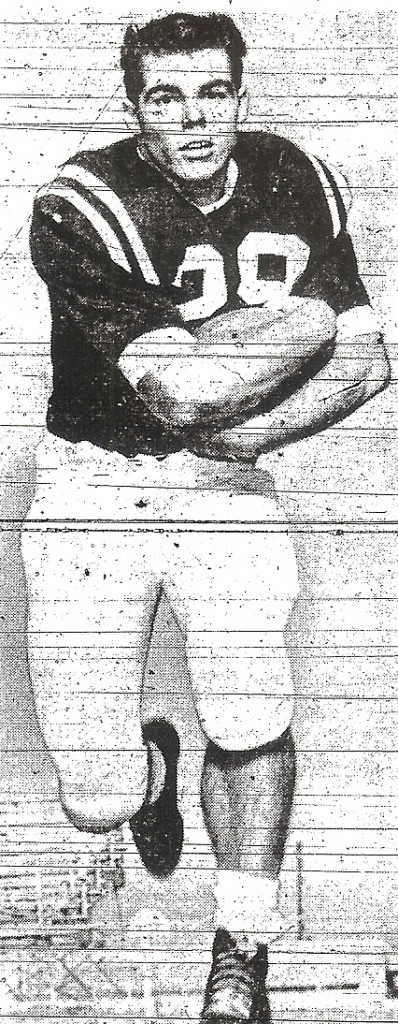
HELP FOR JEFF
A practice injury left Crawford’s Jeff Greenleaf paralyzed from the waist down. To help incur Greenleaf’s hospital bills donations were sought and the Colts met Sweetwater in a Thanksgiving Day, postseason contest at Hoover.
More than 6,000 persons were on hand as Crawford, giving an indication of what to expect in 1961, ran past the Red Devils, 33-9.
The Red Devils’ Ron Miller was held scoreless but still led the County with 13 touchdowns and 78 points. Sweetwater coach Tom Parker donated the game films to Greenleaf’s family.
IT’S SIMPLE, JUST WIN
Army-Navy coach John Maffucci described life at the Carlsbad military academy:
“We’re a boarding school and there is an advantage to having the players on campus most of the time. When we lose, they stay in; when we win, they can go out.”
SIGN OF THE TIME
The frontage road serving hotels in Mission Valley was renamed Hotel Circle by the San Diego City Council.
TRUE GRID
Crawford coach Walt Harvey on running back Jim (Corky) McCorquodale: “He can run, pass, punt, play defense, and block”…Corky was among the County leaders in scoring with 55 points…“We played better in the carnival (21-6 loss in one quarter to San Diego) than we did tonight (7-0 victory over Crawford),” said Kearny coach Birt Slater….Mission Bay outrushed Pomona Catholic, 258-104, and lost, 27-7…obscure name of the year: Vista halfback Joe Picchiottino (pitch-ee-oh-teen-oh)…Point Loma’s Robert Nelson scored on a 48-yard run on his first attempt as a varsity player…Glenn Forsythe returned to Ramona as head coach after one year as a journalism professor at Reedley Junior College near Fresno…defenders of San Diego’s move away from the Southern Section reminded that the AAAA finale between Compton Centennial and Santa Barbara drew only 8,619 persons to the Los Angeles Coliseum… …St. Augustine’s 14-6 victory over San Diego was the Saints’ first ever against the Cavemen…they were 0-8-1 against Cavers teams of different levels dating to 1926…the Saints’ Mickey Frank, 6-foot-3 and 292 pounds, was credited for an outstanding defensive performance…Helix’ defense called itself the “Untouchables”…so did San Diego’s offensive backfield…Vista coach Pat Mongoven had another job, president of the North County community’s American Little League….
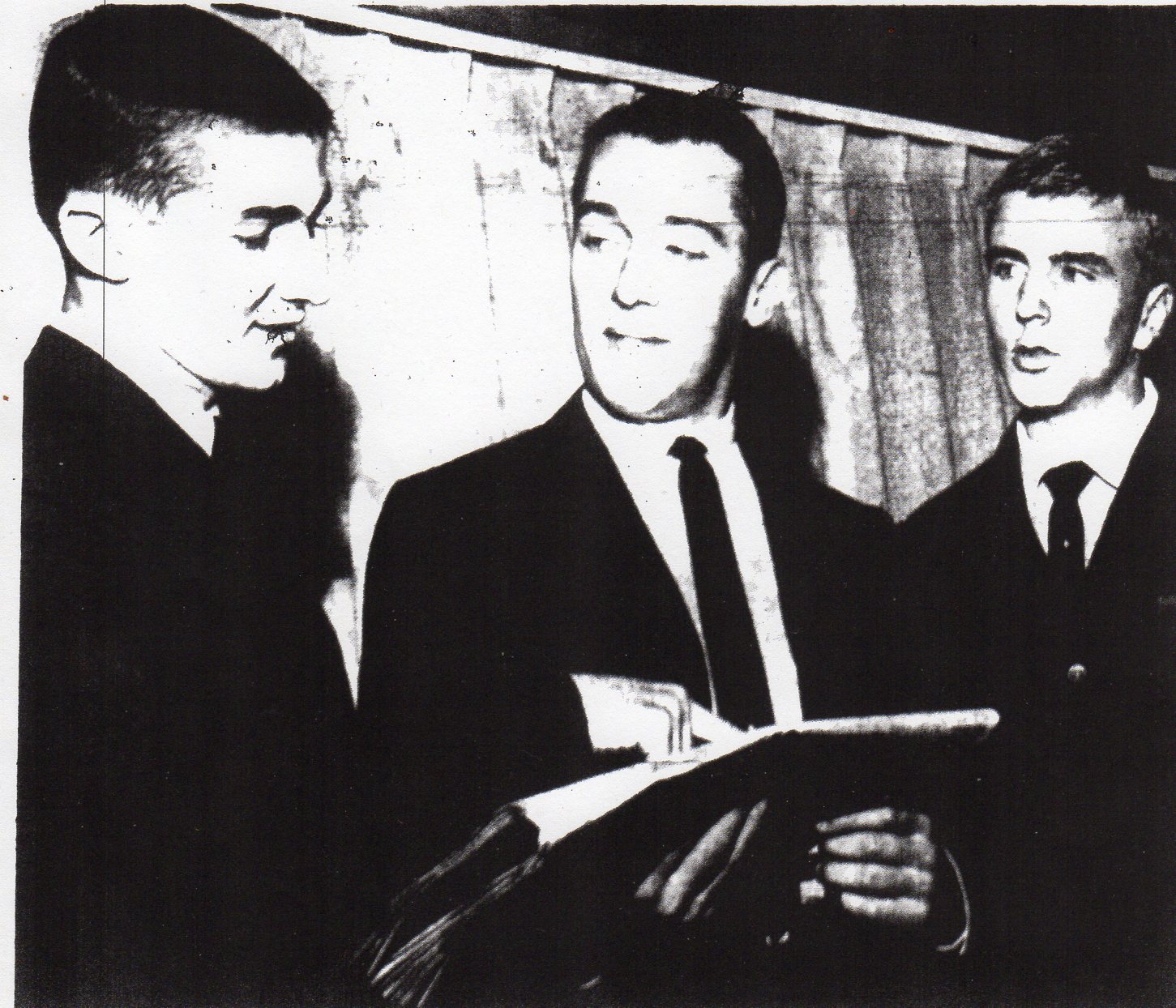
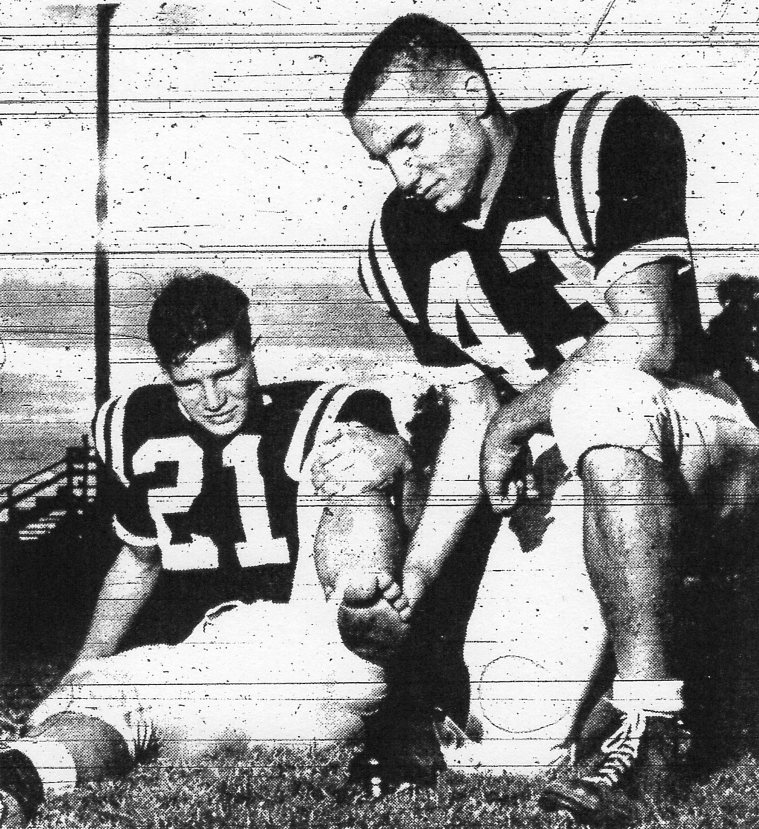

Just some clarification.
Fred Olmstead was the Quarterback for Chula Vista in 1958 When the team won one game.
The next year Olmstead was a halfback and Gary Megglin was the Quarterback on the metro league champions which lost only one game. Mike Collins was an end who later became the basketball coach at Chula Vista for many years.
Olmsted and Scarboro were the essential running backs and Meggelin became the quarterback in 1959. Olmsted, who went to the Air Force Academy, I believe, has commented on our blogs a few times over the years. I’ve heard that Gary Meggelin has passed away. He was 9 for 13 for 119 yards and a touchdown in gthe Spartans’ big win at Escondido, 25-20. Olmsted caught a 10-yard pass for a touchdown from Meggelin.
Please ignore what I said abut 1960 and 1959
You are right we were the 1959 football champs and the class of 1960.
I played fullback, Scarrboro was a halfback along with Fred Olmstead;.
They were all metro and I was all metro honorable mention,
I played against Chula in 59 and always though Fred Olmstead was the QB. I think he went on to the Air Force Academy.
Larry, this is the message I sent to Bill Mayer in the Comments section:
“In reply to Bill Mayer.
Olmsted and Scarboro were the essential running backs and Meggelin became the quarterback in 1959. Olmsted, who went to the Air Force Academy, I believe, has commented on our blogs a few times over the years. I’ve heard that Gary Meggelin has passed away. He was 9 for 13 for 119 yards and a touchdown in the Spartans’ big win at Escondido, 25-20. Olmsted caught a 10-yard pass for a touchdown from Meggelin.”
Bill Mayer says Olmsted was the QB of the 1-7 team in 1958.
I’m looking at a newspaper clipping from the ’58 season, in which Escondido beat Chula Vista, 13-7 and Olmsted had a pass intercepted by Toby Thurlow, who took the ball 42 yards to the house for a TD. Olmsted also passed to Phil Lind for a TD and to Dennis Mesker for a PAT. The stats on the story in the Union said Chula Vista was 11×22 passes for 89 yards and 4 interceptions. Maybe that’s why Olmsted moved to halfback in 1959.
Thanks for reading and writing, Larry. All the best.
I beg to differ with you , but it was 1960. It was basically ME at fullback, Jim Scarborro and Fred Olmstead at halfback. In 1959 we only won one game.
You are right about us keeping the score decent against San Diego in the playoffs.
Ray Smatze was a junior in 1960, I was a senior. We used Ray for short yardage situations that year. Collins was an end.
Bill Mayer
Your loss to Sweetwater was in the 1959 “season”, which was part of the 1959-60 school year. Visit the “Football” menu on the home page and scroll down to “Scores”, which will link to all of them. The 1960 Chula Vista team was 1-7.
I was the Fullback on the 1960 Chula Vista High Metro League Football team Champions.
We lost one game to Sweetwater 7 to 6. We used a T Formation and I usually ran a sweep around the end as I only weighed 143 pounds and used my speed rather than brute strength.
In the Helix High Game I came off the bench and and took a pitchout and ran for 67 yards and a touchdown which boosted my yards per carry average to 9.2 for the season.
I snuck in off the bench without the Coaches permission because I always wanted to play halfback. It was a good thing I scored or I might of been in some trouble.
I think you’re referring to the 1959 season, Bill. Sweetwater and Al Tanoai beat you, 7-6, but you and backfield mate Jim Scarboro (Ray Schmautz and Jim Collins also were on that team, I think) were part of a good Spartans club that kept the score respectable in the playoffs against San Diego. Thank you for writing.
Love the history!! I’m an Oceanside alum and my daughter currently attends and plays basketball. I originally thought avocado league formed when CIF SDS formed in 1960 but in your post you stated that Fallbrook was a member of the avocado league in 1958 and 59. Do you know when avocado league formed? I’m trying to get a history down of how long oceanside was an avocado league member.
Jacob, Oceanside was a charter member when the Avocado League was formed in 1954. It was a member of the Avocado League through 1999. Oeanside joined the new Valley League for 2000 through 2002. It returned to the Avocado from 2003-2007 and went back to the Valley for 2008 and 2009. It was in the Avocado West from 2010-2015 and has been back in the Avocado since 2016. The years I’ve cited are for football seasons; the years overlap for other sports. You can see Oceanside’s affiliation all the way back to its first season by going to the home page and opening the “Football” menu and scrolling to “By Team” or “By Scores”. You also can Search “1953: Avocados and New Schools” for the story on the creation of the League. Thanks for writing.
So sorry to hear about the passing of your father Dick McMinn. He and Harry Johnston were my coaches during the 1961 football season at Mt. Miguel. I loved them both as great mentors, and teachers. 1961 was the year that Monte Vista started, and many of our outstanding athletes were forced to attend the new school which created a huge gap for our athletic programs at Mt. Miguel. Regardless, your Dad, and Harry were great leaders in spite of our diminished resources. My friend, Bill Leep, and I often speak about your father and Harry with reverence and love.
Bob Stephens
My Father, Dick McMinn was a assistant coach on that 1960 Mount Miguel team. He went on to coach football at Grossmont College and won a conference championship there. He also was the golf coach at Grossmont College that won a state championship in 1977 – the only Men’s community college golf team from San Diego to ever win a state championship. Sadly, he passed away 3 weeks ago after a long bout with dementia. He was a great coach and a good guy.
That is a very nice tribute to your father, Gary. I covered the two city leagues, Eastern and Western, so I did not know your dad. Harry Anderson, the Matadors’ coach, was a friend later on when he joined the Chargers staff. Your dad had an outstanding career. You are rightfully proud.
Rick – I believe you may be referring to Harry Johnston ??- my Dad used to talk about him. I believe I have an 8×10 picture of Harry handing a football to my Dad.
Yes, Harry Johnston. He joined Sid Gillman’s Chargers coaching staff. I didn’t mean to enter Harry Anderson on my first reply. I wonder what became of Harry. I think he was a bachelor and had the mobility to move to other coaching jobs.
A follow up: my Dad, Pat Mongoven, died in his 98th year on May 15, 2021, in an assisted-living facility called Merrill Gardens in Oceanside. My mom, Carol (Brooks) Mongoven, was a Washington Jr. High teacher. She died at age 90 in her home at 234 Mar Vista Drive in October 2018. My parents lived at their home since 1963. We all watched John Kennedy’s funeral on TV, and the assassination of Lee Harvey Oswald on our small TV in that home. Dad was admired by many, and beloved by some, of his VHS students from 1957 through 1995. Amazing, Dad! He and those he taught, and taught with, for nearly 40 years will forever be part of the fabric and history of Vista High School.
Hi Rick,
I’m Jan Patrick Mongoven, the son of Pat Mongoven, coach of the Vista Panthers football teams of the late ’50s and early ’60s. One of Dad’s last teams was demolished by Mount Miguel High School nearly sixty years ago. Here’s an update. My mom, Carol Mongoven, died of cancer at age 90 on October 19, 2018. Dad, at age 96, lives on at their home of sixty years on Mar Vista Drive. He’s still pretty sharp in his old age. I appreciate that you’ve noticed that my dad had an influence on athletes at VHS. He coached there from 1958 until his retirement, with his best friends, Marlow Gudmundson and Dick Haines, until 1995. That’s the summer the three of them went out in style!
Jan, let me apologize for being slow to respond. Pat was a gentleman to this 21-year-old reporter covering the 1960 Vista-Mount Miguel game. His assistant coach played the macho role and was almost comical. I loved the old Vista stadium and its environs and the Panthers, outnumbered by the larger school and bigger players, acquitted themselves very well despite the defeat. A tribute to your dad. Thanks for writing.
Thanks, Rick. My father, Pat Mongoven, died at the age of 97 on May 15, 2021. He was beloved by so many of the students that he taught and coached from Wahpeton, North Dakota (1950-1956) and Vista, California (1956-1995). My dad never sought the spotlight. His close, great friend and colleague, Dick Haines, shines above Dad. Still, my father leaves a coaching legacy that VERY few can follow nowadays. RIP Dad (18 Aug 1923 – 15 May 2013). So many of your students and agree…you were an amazing coach, so patient, calm, quiet, kind…and inspirational. Way to go, Dad!
Thanks for writing, Jan. I didn’t know him well but I remember covering the Vista-Mount Miguel playoff game in 1960 and speaking with him a few times. True gentleman, with a much more agreeable personality than his assistant coach. Vista, at that time, should not have been matched against a big school like Mount Miguel and I think the Panthers did not have the full service of their best running back, Joe Piccihitino (don’t trust my spelling on the name), who was overcoming an injury. I’m going to look up my account of that game right now.
Mount Miguel vs Vista, an interesting walk down memory lane; yes it was a mis-match and the disparity in the student body populations was a source of contention for many of us.
I was a member of the Vista team that played Mount Miguel for the Class A championship and can relate to the “too big and too strong” description. As I recall the ‘Miguel’ quarterback was a converted tackle and when they went “student body” right or left was a formidable blocker. It was a real battle in the trenches when all of that blocking hit off tackle, bruised and battered was a good description at the end of the game.
Going to Vista cover a game in 1960 was like a visit to “Mayberry.” The folksy, old stadium. The vista coach, Pat Mongoven, was a nice, understated guy who minded the store for a few years. The assistant coach, however, pursued the hard-assed, tough guy persona. Pagakis was his name. He cracked to me a couple times during the warmups. I’m thinking, “Who’s this —hole?”
Yep, Vista in the 1950s and 1960s was my Mayberry. My dad, Pat Mongoven, still lives with my 88-year-old mom, Carol, in Vista. Both were long, long time teachers in Vista. I was 10 at the time of the “big game,” and I went into it thinking that Dad’s team would destroy the boys from Mt. Miguel. Oops! The Panthers were the roadkill that night. Still, I’ll never forget how exciting the game was for small town Vista, still a decade away from Dick Haines and his Big Red power teams of the ’70s and ’80s. Dad and Dick were such good friends. And, yes, my father still is a “nice, understated guy.”
I remember your father well. He was very courteous and accomodating when I visited the Panthers’ practice a few days before the game. The assistant coach, I think his name was Chris Pagakis, was a real jerk as I remember. That was the first year of the local CIF Section. Mount Miguel had no business being in the same division as Vista, but there weren’t very many schools in the new section and brackets had to be filled. Mongoven was a gentleman in defeat but I don’t think he was happy with the matchup.
Good article Rick — as usual!
I went to school with Dave Blunt. There were not many Escondido fans in the stands that night who knew he could run the 100 yd. dash in less than 10.00 secs. He played baseball the first 3 years and never was a part of the track team. A shoulder injury ended his baseball careet so he went out for track in his senior year.
Not taking anything away from Escondido — which this victory was probably the greatest in the school’s history, the question is what would have the result have been if Duane Maley had stayed one more year for the Cavers? Would have been one heck of a game!
Dave shook up everyone with his track exploits in the spring of 1961, beating the favored city runners. He also was a very good collegiate sprinter at Oregon, running about :20.6 or :20.7 in the 220. I think his younger brother, Bob, was the more accomplished football player but Bob was injured halfway into his senior season. Those Blunt genes certainly worked for Dave’s niece, Erin, who was an outstanding hurdler at San Pasqual. The tragedy was Bob’s death in a small plane crash, right in the prime of his life.
You make a very good point about what impact Duane Maley would have had. San Diego looked great in the football carnival but never really put it together offensively, averaging well under three touchdowns a game. Teams quickly lost their fear of the Cavers. That was an excellent Cougars team.